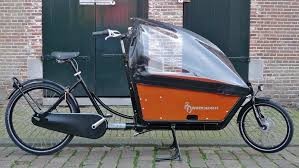Grandma Got Bakfiets
My grandmother was born in 1915, five years after our house was built here in Portland. This weekend, she paid us a visit from her home in Virginia. She’s mentally sharp but frail and severely arthritic, with a history of falls. Naturally, the first thing I could think of is “how are we going to get her on a bike to show her around town?” I feared that getting in and out of the bakfiets might be too challenging, or the position uncomfortable, so I made arrangements a preceding day to borrow a neighborhood friend’s antique Indonesian pedal rickshaw. My test ride of said conveyance — one high fixed gear, piggish handling and a single crude brake — was not too encouraging.
Not knowing whether she’d be game or able to take any sort of bike ride home from the airport, with her luggage, we picked her up with the Flexcar parked two blocks from our home. She emerged from the gate area in a wheelchair. Further discouragement.
But the next morning, against the protests of my wife, grandma and I hatched a plan to line the bak with pillows and a fleece or two, and try. I offered to lift her 110-lb form in and out, but she wanted to swing a leg in herself and work from there. She insisted she was perfectly comfortable. So I called to Martina and Carl to mount up the tandem Brompton, and off we went.
I pointed out to her the iron rings embedded in the curbs, meant for tying up horses, a historical feature preserved by code from the time Portland was developed, when bicycles were the fastest things in the streets. I pointed out the many corner stores, converted for residential use in decades past, that today would not conform to code for lack of parking. We rode by the neighborhood potter and hatter, and by homes with chickens, and food gardens. We rang the bell a lot and waved; many people were too stunned to wave back. Others cheered. Another white-haired lady called out “Am I next?”
Grandma remarked that all the street corners seemed so sharp, and the streets narrow, unlike the speed-engineered sprawling places she has lived much of her life. This reminded her of her girlhood in suburban Chicago. Was she nostalgic, or bemused? Had there been no progress in her life? She was surprised that places like this exist today, or are being reclaimed. My mother, too, on an earlier visit, said she was surprised that Portland’s east side bungalow and arts-and-crafts neighborhoods “hadn’t been razed in the 80s.” No wonder I boycotted the 80s.
We rode through Sunnyside schoolyard full of playing children, and then swung over to Belmont to see the on-street bicycle parking. Then through 33rd and Yamhill, with the huge sunflower/mandala painted by neighbors in the street to reclaim it as public space.
We rolled down Salmon. “This is our high-stress commute; how do you like it?” She chuckled nearly continually. We stopped at the shop. “This isn’t like other bicycle shops!” she kept exclaiming. (“It’s like an art gallery!” is another common reaction). She bought a stylish cap.
We proceeded onto Madison, mixing it up with busses and trucks on the right and left of the bike lane. And then we crossed the Hawthorne bridge. I told her that there are nearly 15,000 daily bicycle crossings of the Willamette now, close to 20% of all vehicles on the Hawthorne. This seemed to be the highlight of the trip for her. She craned her neck to take in the broad blue Willamette view, the dramatic downtown cliffs of glass, metal and stone. She removed her shoes and stuck her feet off the front of the bak to feel the wind in her toes. “I feel like a teenager again!” We peeled off down the defunct Harbor Drive freeway onramp, whose weathered ruin feels to me like a prop from Planet of the Apes, the automotive century, the prime of my grandma’s life. The riverfront was teeming with people enjoying the clear warmth of the day. There’s a large circular fountain shooting arcs of water from the periphery into the center. We rode right through it under the arches of water, catching only a bit of refreshing spray, to the cheers of onlookers.
We returned via Ladd’s Addition and Clinton Streets, stopping a few times to chat with friends. Back near home, she said she was up for more so on we rode to the top of Mt. Tabor. I pointed out downtown in the distance, and she seemed impressed that we had come so far, so fast, so easily.
We also went out to dinner this way, parking on the sidewalk right in front of the restaurant door, and returning after dark. When it came time for her to fly home, she asked if we’d be riding the bakfiets to the airport, and seemed disappointed that I hadn’t left the extra half hour necessary to do that.
I believe that for us in America, and for my son especially, the balance of our lives will resemble a return to some of the logistic conditions of my grandma’s girlhood, or to those of modern Europe or developed Asia. We will live and work in neighborhoods, within a radius of only a dozen miles or so, or else be farmers, or hermits, or professional itinerants, or otherwise exceptional. It will be a recovery rather than a regression, sometimes painful like any forfeiture of investment, but ultimately joyful for those who wake soonest from various American Dreams involving dependence on cars.







